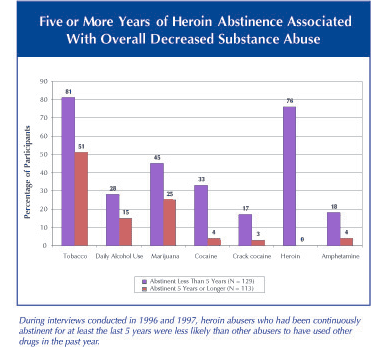Heroin addiction exacts a terrible toll. For many addicts the condition lasts a lifetime–a lifetime shortened by health and social consequences of addiction. NIDA-supported researchers at the University of California, Los Angeles (UCLA), examined the patterns and consequences of heroin addiction over 33 years in nearly 600 heroin-addicted criminal offenders and found that their lives were characterized by repeated cycles of drug abuse and abstinence, along with increased risk of crime or incarceration, health problems, and death.

Drs. Yih-Ing Hser, Valerie Hoffman, Christine Grella, and Douglas Anglin of UCLA’s Drug Abuse Research Center studied a group of 581 male heroin addicts admitted between 1962 and 1964 to the California Civil Addict Program (CAP), a compulsory drug treatment program for criminal offenders. By 1997, nearly half of the group had died, roughly 40 percent of those still living reported using heroin within the past year, and fewer than 10 percent of the survivors were currently enrolled in methadone treatment.
The death rate among the members of the group is 50 to 100 times the rate among the general population of men in the same age range. “The high mortality rate is evidence of the severe consequences of heroin use,” Dr. Hser says. “Even among surviving members of the group, severe consequences such as high levels of health problems, criminal behavior and incarceration, and public assistance were associated with long-term heroin use.”
Researchers first interviewed the participants during the period 1962 through 1964 and conducted followup interviews at roughly 10-year intervals–in 1974 and 1975, 1985 and 1986, and 1996 and 1997. In the most recent interviews, the UCLA researchers found that 284 (49 percent) of the 581 addicts enrolled in CAP between 1962 and 1964 had died. The most common cause of death (21.6 percent) was accidental poisoning or drug overdose. Homicide, suicide, or accident accounted for 19.5 percent of deaths, and the next most common causes were liver disease, cancer, and cardiovascular diseases (15.2, 11.7, and 11.7 percent, respectively). Fifty-five original participants could not be located, refused to be interviewed, or could not be interviewed.
Of the 242 surviving members interviewed in 1996 and 1997, 135 (55.8 percent) were not currently using heroin, 50 (20.7 percent) were actively using heroin, and 23 (9.5 percent) refused to provide urine samples for testing. In addition, urine samples were not available from 34 men who were incarcerated at the time of the interviews.

During any given year, roughly 10 percent of participants were in treatment, according to Dr. Hser. “Although many of the survivors reported that they had been able to stop using heroin for extensive periods, fewer than half reported abstinence for periods of more than 5 years,” Dr. Hser says. “Abstinence for 5 years significantly reduced the likelihood of relapse, but even among those who achieved 15 years of abstinence, a quarter still relapsed.” Those who achieved abstinence for more than 5 years were more likely to be employed and less likely to report that they had health problems that prevented them from working, were receiving public assistance, or had been involved in criminal activity than were the rest of the cohort. Rates of HIV, hepatitis, and sexually transmitted diseases did not differ very much between those who had achieved more or less than 5 years of abstinence.
Dr. Hser adds that the results of the 33-year followup study should be considered in light of the fact that all members of the study originally were selected from a corrections-based treatment program and may not be representative of addicts who would have voluntarily sought treatment in community-based facilities had those programs been available 30 years ago. “Nevertheless, we believe the findings on patterns of heroin use and related consequences have important implications for the study of heroin addicts generally,” Dr. Hser says. “These results suggest that heroin addiction treatment programs should prepare addicts for the fact that relapse is a very real possibility. Most people go into treatment thinking that they will be cured and not return to addiction, but abstinence is very difficult to maintain.”
Heroin addicts and treatment providers should understand that treatment is a way to achieve abstinence and that recovery consists of improvements resulting from those periods when they are free of addiction, Dr. Hser says.
Source
- Hser, Y-I.; Hoffman, V.; Grella, C.E.; and Anglin, M.D. A 33-year follow-up of narcotics addicts. Archives of General Psychiatry 58(5):503-508, 2001.
